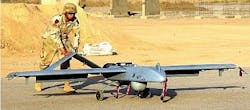AAI taps into UAV sales and upgrades at Farnborough with $358 million Shadow contract from U.S. Army
FARNBOROUGH, England, 10 July 2012. AAI Unmanned Aircraft Systems in Hunt Valley, Md., will upgrade and support a fleet of 45 RQ-7B Shadow tactical unmanned aerial vehicles (UAVs) for the U.S. Army and Marine Corps under terms of a $358 million contract announced Monday at the Farnborough International Airshow in Farnborough, England.
The contract, from the Army's Program Manager for Unmanned Aircraft Systems, calls for deliveries of 43 systems for the Army and two for the Marine Corps to begin in late 2013.
The RQ-7B builds on the same architecture as the current Shadow aircraft. It is multi-mission equipped with an integrated payload for day and night imagery, as well as communications relay and laser target designation. The aircraft also increases digital data communications bandwidth.
"The RQ-7B Shadow upgrade, dubbed V2 by the Army, includes enhancements to every part of the system, from the aircraft itself to the ground and support systems," says Steven Reid, senior vice president and general manager of AAI Unmanned Aircraft Systems. "The Shadow system will perform even more reliably in core areas including intelligence, surveillance and reconnaissance; target designation; communications relay; and battlefield damage assessment; but it also will excel in new missions such as manned and unmanned teaming."
Upgrades include increased endurance from six to nine hours; extended wing with hard points to carry external stores and payloads; electronic fuel injection engine; the Tactical Common Data Link for digital data dissemination and encryption; Universal Ground Control Station (UGCS); Universal Ground Data Terminal (UGDT); Portable Ground Data Terminal (PGDT); and Portable Ground Control Station (PGCS).
Addition of the UGCS and UGDT to the RQ-7B Shadow system supports the Army's vision for a universal unmanned aircraft systems operator, and streamlines the development of new mission sets including manned/unmanned teaming.
"With common hardware, software, controls and user interfaces, the UGCS has been proven interoperable with the Army's Gray Eagle and Hunter assets, as well as the Shadow system," Reid says. "It also complies with unmanned aircraft systems interoperability recommendations including NATO Standardization Agreement 4586."
The UGCS includes comfortable seating; individually controlled vents for heating and air conditioning; dual 30-inch monitors; more leg room; white boards; and centrally located radios.
For more information contact AAI Unmanned Aircraft Systems online at www.aaicorp.com/products/uas, or the Farnborough International Airshow at www.farnborough.com. Also follow Military & Aerospace Electronics and Avionics Intelligence daily Farnborough show coverage online at www.militaryaerospace.com/farnborough-report.
Follow Military & Aerospace Electronics and Avionics Intelligence news updates on Twitter
